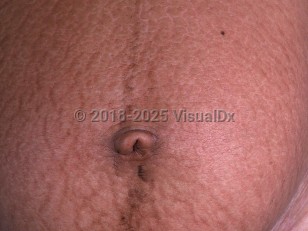Striae in Adult
Alerts and Notices
Important News & Links
Synopsis

Periods of rapid growth, such as puberty, pregnancy (striae gravidarum), training with weight lifting, rapid weight gain, and adolescent growth spurts, are common triggers. Striae also commonly occur in the setting of obesity. As 60%-70% of the US population is labeled as overweight or obese, the prevalence of striae from obesity is estimated at 40%. The skin findings themselves are rarely symptomatic, but they may occasionally indicate an underlying disease state (such as Cushing syndrome). In Marfan syndrome, striae are seen in around two-thirds of patients. Striae tend to flatten and become less conspicuous over time.
Bevacizumab, a vascular endothelial growth factor (VEGF) inhibitor, has been reported to cause ulceration of striae that have been induced by concurrent systemic glucocorticoid therapy.
Related topic: drug-induced skin ulcers
Codes
L90.6 – Striae atrophicae
SNOMEDCT:
201066002 – Skin striae
Look For
Subscription Required
Diagnostic Pearls
Subscription Required
Differential Diagnosis & Pitfalls

Subscription Required
Best Tests
Subscription Required
Management Pearls
Subscription Required
Therapy
Subscription Required
Drug Reaction Data
Subscription Required
References
Subscription Required
Last Updated:09/17/2020
 Patient Information for Striae in Adult
Patient Information for Striae in Adult- Improve treatment compliance
- Reduce after-hours questions
- Increase patient engagement and satisfaction
- Written in clear, easy-to-understand language. No confusing jargon.
- Available in English and Spanish
- Print out or email directly to your patient


